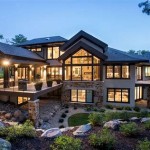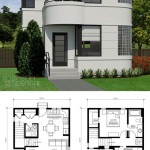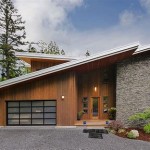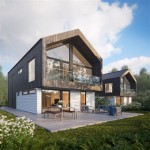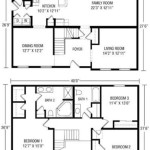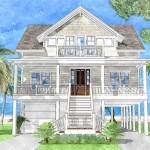A house plan for 3 bedrooms is a blueprint that details the layout and design of a residential dwelling intended to accommodate three separate sleeping quarters, or bedrooms. These plans typically include specifications for the dimensions, placement, and arrangement of rooms, as well as the location of amenities such as bathrooms, kitchens, and living areas. Architects and builders use house plans to guide the construction and renovation of homes, ensuring that the final product meets the needs and preferences of the occupants.
When considering a 3-bedroom house plan, factors such as the size of the property, the number of occupants, and the desired level of privacy and convenience should be taken into account. These plans can vary significantly in terms of layout, architectural style, and the inclusion of additional features such as garages, basements, or outdoor living spaces. Whether you are a first-time homeowner or an experienced builder, a carefully chosen house plan is essential for creating a functional and comfortable living environment.
In the following sections, we will delve into the key aspects to consider when selecting a 3-bedroom house plan, including the advantages and disadvantages of different layouts, design options, and the importance of professional guidance throughout the planning and construction process.
A well-crafted house plan for 3 bedrooms can lay the foundation for a comfortable and functional living space. Here are 10 important points to consider:
- Layout optimization
- Adequate space planning
- Natural light incorporation
- Smart storage solutions
- Energy efficiency features
- Outdoor living integration
- Future expansion potential
- Accessibility considerations
- Professional guidance
- Personalization options
By carefully considering these factors, homeowners can create a 3-bedroom house plan that meets their unique needs and aspirations.
Layout optimization
Layout optimization is crucial in designing a 3-bedroom house plan to ensure efficient use of space, smooth traffic flow, and a comfortable living environment. Here are some key considerations:
- Open floor plan: An open floor plan combines multiple functional areas, such as the living room, dining room, and kitchen, into one large, open space. This layout promotes a sense of spaciousness, allows for natural light penetration, and facilitates interaction among occupants.
- Closed floor plan: In contrast to an open floor plan, a closed floor plan features separate, enclosed rooms for different functions. This layout offers more privacy, reduces noise transmission, and provides designated spaces for specific activities.
- Hybrid floor plan: A hybrid floor plan strikes a balance between open and closed floor plans by incorporating both open and closed spaces. This layout allows for a sense of openness while still providing some separation between different functional areas.
- One-story vs. two-story: The choice between a one-story and a two-story house plan depends on factors such as lot size, budget, and personal preferences. One-story plans offer convenience and accessibility, while two-story plans provide more privacy and separation between living and sleeping areas.
Optimizing the layout of a 3-bedroom house plan involves carefully considering the flow of movement, the placement of windows and natural light sources, and the overall functionality of the space. By taking these factors into account, homeowners can create a layout that meets their specific needs and enhances their daily lives.
Adequate space planning
Adequate space planning is essential in designing a 3-bedroom house plan to ensure comfortable living and efficient use of space. Here are four key considerations:
- Room dimensions: The size of each room should be carefully considered to accommodate furniture, movement, and activities. Bedrooms should be large enough to fit a bed, dresser, and other necessary furniture comfortably. Bathrooms should provide sufficient space for fixtures, storage, and movement. Living areas should be spacious enough to accommodate seating, entertainment systems, and other amenities.
- Circulation space: Adequate circulation space, or hallways and corridors, is crucial for comfortable movement throughout the house. Hallways should be wide enough to allow for easy passage of people and furniture. Corridors should provide clear and efficient connections between different rooms.
- Storage solutions: Ample storage space is essential for keeping the house organized and clutter-free. Built-in closets, cabinets, and shelves can be incorporated into the design to maximize storage capacity. Consider including dedicated storage areas for seasonal items, cleaning supplies, and other belongings.
- Future needs: When planning the space, consider potential future needs and changes in household composition. For example, if you plan to have children in the future, you may want to design a house plan that can accommodate additional bedrooms or a playroom. Similarly, if you anticipate aging in place, you may want to incorporate accessible features and single-story living.
By carefully considering adequate space planning, homeowners can create a 3-bedroom house plan that meets their current and future needs, ensuring a comfortable and functional living environment.
Natural light incorporation
Incorporating natural light into a 3-bedroom house plan offers numerous benefits, including improved mood, increased energy levels, and reduced reliance on artificial lighting. Here are four key considerations for maximizing natural light in your home design:
- Window placement: The strategic placement of windows can significantly impact the amount and quality of natural light entering a space. Consider the orientation of your house on the lot and the position of the sun throughout the day. Place windows on the south-facing side of the house to take advantage of the most sunlight. Additionally, consider installing skylights or clerestory windows to bring light into interior spaces or areas with limited exterior walls.
- Window size and shape: The size and shape of windows can also affect the amount of natural light entering a space. Larger windows allow for more light, while smaller windows can provide more privacy. Consider using floor-to-ceiling windows or bay windows to maximize natural light and create a sense of spaciousness. Experiment with different window shapes, such as arched windows or picture windows, to add architectural interest and enhance the flow of light.
- Window treatments: Window treatments, such as curtains, blinds, and shades, can be used to control the amount and direction of natural light entering a space. Choose light-colored, sheer fabrics that allow natural light to filter through while still providing privacy. Avoid using heavy drapes or curtains that block out most of the light. Consider installing motorized window treatments for convenience and ease of use.
- Reflective surfaces: Reflective surfaces, such as mirrors and white walls, can bounce natural light around a space, making it appear brighter and more spacious. Place mirrors opposite windows to reflect light deeper into the room. Use light-colored paint or wallpaper on walls and ceilings to enhance the reflective properties of the space.
By carefully considering natural light incorporation in your 3-bedroom house plan, you can create a bright, inviting, and energy-efficient living environment.
Smart storage solutions
Incorporating smart storage solutions into a 3-bedroom house plan is crucial for maintaining a tidy and organized living space. Here are four key considerations for maximizing storage capacity and functionality:
- Built-in storage: Built-in storage, such as closets, cabinets, and shelves, is a great way to maximize space and keep belongings organized. Consider incorporating built-in storage into walls, under stairs, and in awkward spaces. Custom-designed built-in storage can be tailored to specific needs and preferences, ensuring optimal utilization of space.
- Multi-purpose furniture: Multi-purpose furniture pieces can serve multiple functions and save valuable space. For example, ottomans with built-in storage can provide extra seating and a place to store blankets or toys. Beds with drawers or built-in headboards with shelves can offer additional storage for bedding, books, or other items.
- Vertical storage: Utilizing vertical space is essential for maximizing storage capacity. Install shelves and cabinets that reach up to the ceiling to store items that are not frequently used. Use stackable bins and containers to organize items vertically in closets and drawers. Consider using hanging organizers to store items on the back of doors or in unused spaces.
- Decluttering and organization: Regularly decluttering and organizing belongings can help reduce the need for storage space. Donate or discard items that are no longer needed. Implement organizational systems, such as using drawer dividers or shelf organizers, to keep items tidy and easy to find.
By carefully considering smart storage solutions in your 3-bedroom house plan, you can create a home that is both functional and aesthetically pleasing.
Energy efficiency features
Insulation
Proper insulation is crucial for maintaining a comfortable indoor temperature and reducing energy consumption. In a 3-bedroom house plan, insulation should be installed in the attic, walls, and floors. Attic insulation prevents heat from escaping through the roof, while wall and floor insulation minimize heat transfer between the interior and exterior of the house. Common insulation materials include fiberglass, cellulose, and spray foam, each with its own advantages and R-value (resistance to heat flow).
Windows and doors
Energy-efficient windows and doors play a significant role in reducing heat loss and gain. Look for windows with double or triple glazing, low-emissivity (Low-E) coatings, and ENERGY STAR certification. Low-E coatings reflect heat back into the house during winter and reduce solar heat gain during summer. Properly sealed doors and windows prevent air leakage, which can account for significant energy loss.
Heating and cooling systems
Choosing energy-efficient heating and cooling systems is essential for reducing energy consumption. Consider installing a high-efficiency furnace or heat pump, which can provide both heating and cooling. Look for systems with a high SEER (Seasonal Energy Efficiency Ratio) or HSPF (Heating Seasonal Performance Factor) rating. These ratings indicate the system’s efficiency in converting energy into heating or cooling.
Renewable energy sources
Incorporating renewable energy sources into your 3-bedroom house plan can further reduce energy consumption and environmental impact. Solar panels can be installed on the roof to generate electricity from sunlight. Solar water heaters can provide hot water, reducing the load on the conventional water heater. Geothermal heat pumps utilize the earth’s constant temperature to heat and cool the home efficiently.
Outdoor living integration
Integrating outdoor living spaces into a 3-bedroom house plan enhances the overall functionality and enjoyment of the home. Here are four key considerations for seamless indoor-outdoor living:
- Patios and decks: Patios and decks extend the living space outdoors, providing areas for relaxation, dining, and entertainment. Patios can be constructed from materials such as concrete, pavers, or stone, while decks are typically made of wood or composite materials. Consider the size, shape, and location of the patio or deck in relation to the house and surrounding landscape.
- Porches and verandas: Porches and verandas offer covered outdoor living spaces that provide shelter from the sun and rain. They can be attached to the house or freestanding structures. Porches are typically enclosed by screens or railings, while verandas are often open-air with a roof overhead. Screened porches are ideal for enjoying the outdoors without the nuisance of insects.
- Landscaping: Landscaping plays a crucial role in creating a cohesive indoor-outdoor living environment. Plant trees and shrubs to provide shade and privacy. Create flower beds and gardens to add color and fragrance to the outdoor space. Consider installing outdoor lighting to extend the use of the space into the evening hours.
- Access points: Seamless access between the indoor and outdoor living spaces is essential. Large sliding glass doors or French doors provide easy transitions from the interior to the exterior. Consider the placement of windows and doors to maximize natural light and ventilation.
By carefully considering outdoor living integration in your 3-bedroom house plan, you can create a home that seamlessly connects indoor and outdoor spaces, enhancing the overall enjoyment and functionality of your living environment.
Future expansion potential
When considering a 3-bedroom house plan, it is important to think about the future and the potential need for expansion. Whether you plan to start a family, accommodate aging parents, or simply add more living space, designing a house with future expansion potential can save you time and money in the long run.
One way to incorporate future expansion potential is to choose a house plan with a flexible layout. This means avoiding fixed walls and partitions that would make it difficult to add on to the house later. For example, an open floor plan with minimal interior walls allows for greater flexibility in reconfiguring the space as needed.
Another important consideration is the availability of land around the house. If you have a large lot, you have more options for expanding the house in the future. Consider leaving extra space on the sides or back of the house for potential additions, such as a sunroom, family room, or additional bedrooms.
In addition to physical space, it is also important to consider the infrastructure of the house when planning for future expansion. Ensure that the electrical, plumbing, and HVAC systems have the capacity to support additional rooms or appliances. This may involve installing larger electrical panels, water lines, or HVAC units to accommodate the increased demand.
By carefully considering future expansion potential in your 3-bedroom house plan, you can create a home that can adapt and grow to meet your changing needs over time.
Accessibility considerations
When designing a 3-bedroom house plan, it is essential to consider accessibility features that promote inclusivity and ease of movement for all occupants, regardless of age or ability. Here are four key accessibility considerations to incorporate into your plan:
- Step-free access: Eliminate steps and thresholds wherever possible to ensure smooth and easy movement throughout the house. This includes providing ramps or gradual slopes at entrances, doorways, and between different levels of the house. Step-free access is particularly important for individuals using wheelchairs, mobility scooters, or walkers.
- Wider doorways and hallways: Standard doorways and hallways may not be wide enough for wheelchairs or other mobility aids to pass through comfortably. Consider widening doorways to at least 32 inches and hallways to at least 36 inches to accommodate wheelchairs and ensure easy maneuverability.
- Accessible bathrooms: Bathrooms should be designed with accessibility in mind, featuring wider doorways, roll-in showers or walk-in tubs, grab bars, and adjustable showerheads. Consider installing a bathroom on the main floor to eliminate the need for stairs.
- Universal design principles: Universal design principles aim to create spaces that are accessible and usable by people of all abilities. Incorporate these principles into your house plan by using lever handles instead of knobs, installing non-slip flooring, and providing clear and concise signage.
By carefully considering accessibility considerations in your 3-bedroom house plan, you can create a home that is inclusive, comfortable, and safe for all occupants.
In addition to the key accessibility considerations mentioned above, there are other details to keep in mind when designing an accessible 3-bedroom house plan. These include:
- Kitchen accessibility: Ensure that the kitchen is accessible by providing lower countertops, adjustable sink heights, and pull-out shelves.
- Laundry accessibility: Place the laundry room on the main floor and provide front-loading appliances for easy access.
- Smart home features: Incorporate smart home features, such as voice-activated controls and remote monitoring, to enhance accessibility and independence.
- Future considerations: Design the house with future accessibility needs in mind, such as installing grab bars in bathrooms and reinforcing walls for potential future installation of assistive devices.
Professional guidance
When it comes to designing a 3-bedroom house plan, seeking professional guidance from architects, builders, or designers can be invaluable. Here are four key benefits of working with professionals:
- Expertise and experience: Architects and builders have the knowledge and experience to help you create a house plan that meets your specific needs and preferences. They can provide valuable insights into design options, materials, and building codes to ensure a functional and safe living space.
- Objectivity and unbiased advice: Professionals can provide unbiased advice and help you make informed decisions about your house plan. They are not influenced by personal preferences or emotional attachments and can offer objective perspectives on design and functionality.
- Cost-saving and efficiency: Working with professionals can help you save money and time in the long run. They can help you avoid costly mistakes and ensure that your house plan is designed efficiently, reducing construction costs and future maintenance expenses.
- Legal compliance and building codes: Architects and builders are familiar with building codes and regulations. They can ensure that your house plan complies with all applicable codes, preventing potential legal issues and ensuring the safety and habitability of your home.
Overall, seeking professional guidance for your 3-bedroom house plan can provide you with peace of mind, ensure a well-designed and functional living space, and protect your investment in the long run.
Personalization options
When it comes to designing a 3-bedroom house plan, personalization options allow you to create a home that truly reflects your unique style and preferences. Here are four key areas where you can customize your house plan:
- Architectural style: Choose from a wide range of architectural styles, such as traditional, contemporary, modern, rustic, or craftsman, to create the exterior aesthetic that best suits your taste and the surrounding neighborhood.
- Interior layout: Personalize the interior layout to fit your lifestyle and needs. Decide on the number and size of bedrooms, bathrooms, and other rooms, and arrange them in a way that maximizes functionality and flow.
- Finishes and materials: Select finishes and materials that reflect your personal style and create the desired ambiance. Choose from a variety of options for flooring, countertops, cabinetry, paint colors, and fixtures to create a cohesive and visually appealing interior.
- Outdoor living spaces: Customize your outdoor living spaces to suit your preferences and climate. Design a patio or deck for outdoor relaxation and entertaining, add a screened porch for bug-free enjoyment, or incorporate a swimming pool or fire pit to enhance your outdoor experience.
By carefully considering these personalization options, you can create a 3-bedroom house plan that is tailored to your specific needs and desires, resulting in a home that is both functional and a true reflection of your personal style.
In addition to the key personalization options mentioned above, there are other details to keep in mind when designing a personalized 3-bedroom house plan. These include:
- Energy efficiency: Incorporate energy-efficient features into your house plan to reduce your environmental impact and save money on energy bills.
- Smart home features: Integrate smart home features, such as automated lighting, voice-activated controls, and security systems, to enhance convenience, safety, and energy efficiency.
- Universal design: Consider incorporating universal design principles to create a home that is accessible and comfortable for people of all ages and abilities.
- Future needs: Think about your future needs and goals when designing your house plan. Consider potential changes in family size, lifestyle, and accessibility requirements.










Related Posts

